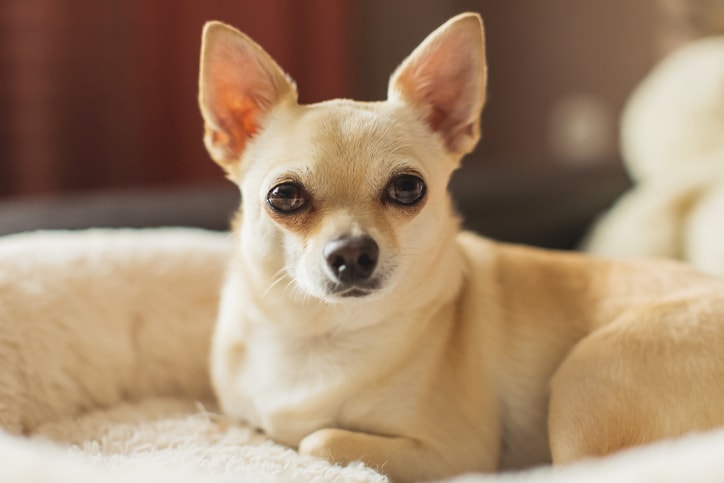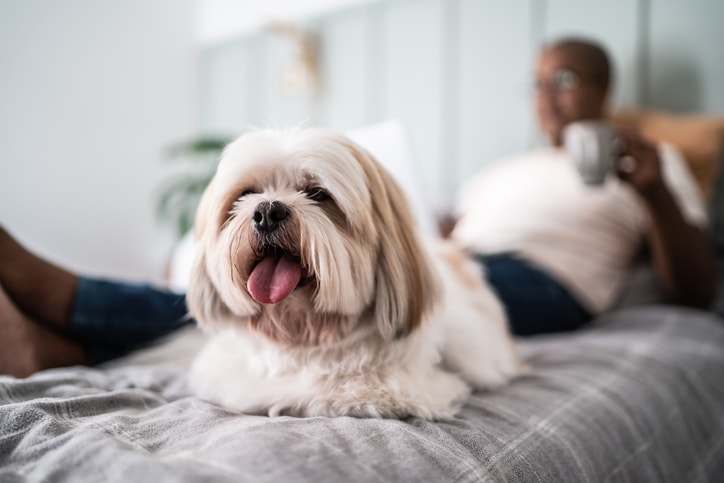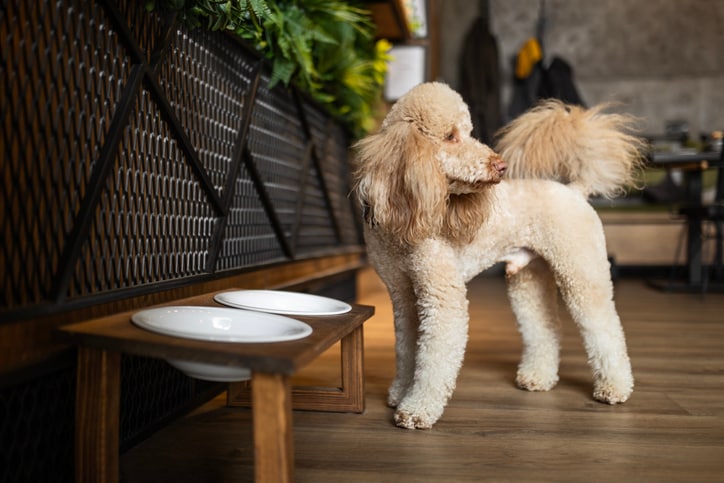Are you dreaming of adopting a dog, but don’t think it would be fair to raise your pup in an apartment? As it turns out, you don’t need a mortgage to give your dog a happy home. Around 62% of renters have at least one dog in their rented living space, according to Apartments.com.
That said, renting with Rufus is what you make it. “Finding the right pet in an apartment is all about knowing yourself and your environment and picking not only the right breed to match your lifestyle but that special something that makes each and every dog unique,” says Dr. Andrew Findlaytor, senior director of veterinary strategy and services at Roo.
Join Care for free
We asked veterinarians and dog behaviorists what dogs are best for apartments, how to match the right breed to your rental and lifestyle and how to give your dog the best chance of living large in a small space.
What makes for good apartment dogs?
While it may seem natural to expect only small dogs to fit a smaller living space, our experts agree that this is a common misconception. Many large dogs thrive in apartments. Meanwhile, small breeds that are especially vocal or energetic may need extra training to adapt to apartment living.
“When it comes to choosing a dog for apartment living, look for docile breeds with calm demeanors and low to moderate energy requirements,” says Dr. Gabre Denton, veterinarian with TeachMe.to. “Assuming adequate living space for a dog bed and separate feeding area, large breed dogs can be suitable as well as small breeds. They should be adaptable and easy to train, especially when it comes to housebreaking.”
Ultimately, you want a companion that’s happy with short walks and some indoor playtime without needing a ton of space, Denton adds.
“French Bulldogs are renowned for their affectionate nature and low maintenance costs. These dogs are content lounging around and do not require extensive exercise.”
Joanna Herberger, veterinary consultant for PetSprint
10 best dogs for apartments, recommended by vets
1. French bulldog

With their compact size and larger-than-life personality, it’s easy to see why the French bulldog leads the list of the most popular dog breeds in the US. These bat-eared dogs are exceptionally cuddly and known to get along splendidly with children and other pets, even when sharing small spaces.
“French bulldogs are renowned for their affectionate nature and low maintenance costs,” says Joanna Herberger, veterinary consultant for PetSprint. “These dogs are content lounging around and do not require extensive exercise.”
2. Chihuahua

Weighing in at around five pounds, the Chihuahua is a pint-sized pup that’s comfortable even in the smallest studios. What they lack in size they more than make up for in decibels, though, so you’ll want to start training right away to discourage barking if your complex has thin walls.
“Chihuahuas tend to be very loving dogs, however are known to be more overprotective and can bark more excessively than other breeds. As apartment dogs this can pose a problem, but if trained well and socialized well with both humans and dogs from a young age, this decreases anxiety-related barking and overprotective traits,” advises Denton.
3. Greyhound

The greyhound is a medium-large breed that weighs around 65 pounds. While this breed is famous for now-banned dog races, you don’t need to own a racetrack to make space for these graceful, well-mannered dogs. In fact, these sleek sprinters are content to lounge around after short, moderate bursts of exercise.
“Greyhounds have a racing background but are surprisingly lazy and make excellent companions for tiny homes,” says Herberger.
4. Shih tzu

The shih tzu is a popular apartment dog and the 20th most popular breed overall. “Shih tzus adapt easily to households and are low-maintenance. These pint-sized dogs are happy to guard your home,” says Herberger.
The shih tzu’s silky coat is low-shedding and surprisingly easy to care for, requiring a quick brush each day. Keeping their coat clipped can make their coat even easier to maintain. Outgoing and affectionate, it’s easy to see why these little “lion dogs” are so popular.
5. Poodle

The regal, intelligent standard poodle is another great match for apartment dwellers. Their non-shedding coat requires regular grooming, but won’t overwhelm your small space with a flurry of fur. Like other working breeds, they need plenty of exercise and mental stimulation. All three sizes, from the toy and mini poodle to the large standard poodle, can make wonderful apartment pups and exceptional family dogs.
“Larger dogs like labs and poodles can sort of ‘go with the flow’ of life, meaning if you are active, they will absolutely keep up and if you are a bit more laid back, they will likely match you,” says Findlaytor.
6. Great Dane

When it comes to adopting a Great Dane, it’s not so much the size of your house, as it is the size of your couch. According to the AKC, these tall dogs grow up to 32 inches at the shoulder and can weigh around 140 pounds. While they need room to stretch their legs, they love long naps punctuated by short walks throughout the day.
7. Cavalier King Charles Spaniel

Originally bred to warm the laps of British royals, the Cavalier King Charles Spaniel is a classic companion dog that fits snugly in small living spaces. Maxing out at around 25 pounds, they’re similar in size to a toy breed and have a warm, outgoing personality that’s best described as “a small golden retriever.”
These personable pups can struggle with separation anxiety, though, and can be prone to barking if left alone. “Cavaliers are typically very well mannered dogs who are very loving and friendly. If given plenty of love, attention and exercise they can be great apartment dogs,” says Denton.
8. Yorkshire terrier

Though they’re part of the toy breed group, the Yorkshire terrier has plenty of “terrier-tude,” with an alert, fearless personality that dates back to their vermin-chasing days. Topping out at just seven pounds, they’re travel-sized and can get the exercise they need with city walks or indoor activities.
“Yorkies can be anxious if not trained and socialized well from a young age, but with proper training can be a fantastic option. These dogs are well suited to an apartment situation as long as getting enough exercise, mental stimulation and emotional enrichment,” says Denton.
9. Mastiff

The heaviest breed in the dog world, easily exceeding 200 pounds when fully grown, may not be the best match for apartment complexes with weight or breed restrictions. With your leasing office’s approval, though, the mastiff can make a great apartment pet. This breed has relatively low exercise requirements, doesn’t bark much and has a loving, patient nature, to which they owe their reputation as gentle giants.
“There are many pet owners all over the world who have large breed dogs in small apartment units. Dogs like labrador retrievers, goldens, Newfoundlands and mastiffs can all make great family members in your apartment — although probably not all at once,” shares Findlaytor. “Although grand in size, these dogs are highly intelligent, helping them navigate the ins and outs of apartment life. This makes it easier to train them and overall helps them settle into a routine.”
10. Pug

You likely recognize this iconic toy breed weighing in at around 10 to 25 pounds. Famous for their clownish disposition and adorably squishy faces, these dogs are a great match for urban living apartment dwellers. “Pugs love human companionship and adapt beautifully to smaller spaces,” says Herberger.
Pugs don’t require much exercise and can be sensitive to extreme temperatures, making them a great match for laid-back pet parents. Short daily walks, indoor exercise and unlimited cuddles are key to keeping this pig-tailed pup happy and healthy.
How to help your dog adapt to apartment life
Whether you’re adopting while you already live in an apartment or downsizing with your dog, veterinarians recommend keeping your dog’s needs in check to help reduce unwanted behaviors like excessive barking and destructive chewing.
Make sure your dog gets enough exercise
Even low-energy breeds need at least 30 minutes of daily exercise, which can be broken up into short walks throughout the day. A dog walker can be your dog’s second best friend, especially if you work long hours.
Provide plenty of mental stimulation
Keep your dog engaged in any small space with food puzzles, interactive dog toys, indoor games like hide-and-seek, trick-training and nosework activities.
Start socialization early
Expose your dog to different people and environments to get them used to busy urban life.
Look for dog-friendly amenities
Some apartment complexes have dog parks, pet washing stations and other amenities for pets, or there may be pet-friendly businesses and services nearby.
Rent a ground-floor apartment, if possible
Not only will you have quick access to the outdoors, any barking will be less likely to disrupt your neighbors.
The bottom line
Many dog breeds can be great companions for apartment living, and the number of options might surprise you.
If behavioral issues do arise, Denton recommends reaching out to a professional for help as soon as possible. “Speaking with a veterinarian about the anxiety and potentially including a dog trainer is the best way to help redirect anxious behavior. [It’s] always best to do this as early as possible, which will make it easier to modify these anxious behaviors.”
